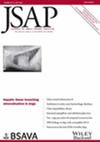The aim of this study is to retrospectively report complication and infection rates associated with the use of Penrose drains in a large population of dogs; and to compare complication and infection rates of dogs hospitalised for maintenance of their Penrose drains with those that were discharged home with their drains in place.
We performed a retrospective search of medical records from 2014 to 2022 for dogs that had a Penrose drain placed into a wound in one institution. Our population was sub-divided into dogs discharged home with a drain in place; dogs discharged only after drain removal; and dogs recovered part of the time in hospital and part at home (with the drain in situ). Postoperative complications were graded using the Clavien-Dindo scale.
Two hundred and eight dogs were included. The overall complication rate was 40.9% (85/208), with most complications considered minor. The overall infection rate was 16.9% (35/207). Dogs discharged home with the drain in situ <24 hours after surgery (n=136) had similar complication (39.0%) and infection (16.2%) rates to dogs kept hospitalised for drain care (n=50, 42.9%, 18.4%) and dogs kept hospitalised for >24 hours but discharged with the drain in situ (n=18, 50.0%, 22.2%).
Our study results show no significant influence on the complication or infection rates between dogs that were hospitalised for drain care and those discharged home with drains in situ within 24 hours of surgery.


